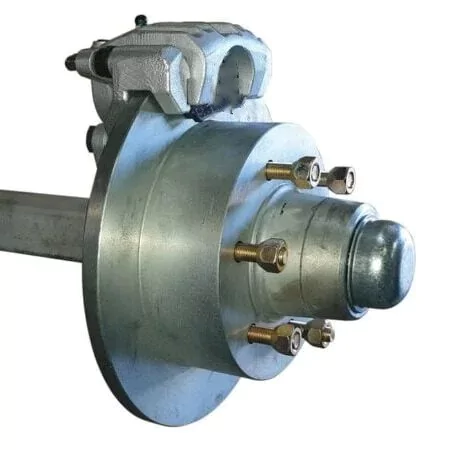Definition and Importance of a Trailer Axle
A trailer axle is a vital part as it connects the wheels and allows them to rotate freely, ensuring smooth movement. The trailer axle also bears the weight of the trailer’s load, spreads it evenly, and maintains balance. This functionality is indispensable for both safety and performance, making it a critical element for any trailer. Moreover, a properly functioning axle is essential for maintaining the longevity of the trailer and preventing potential breakdowns or accidents on the road.
Types of Trailer Axles
Disc-braked Axle
A disc-braked axle is fitted with disc brakes, similar to those found in many modern vehicles. Disc brakes provide superior stopping power and heat dissipation, which can be particularly useful for trailers carrying heavy loads. These axles are designed to offer enhanced braking efficiency, which increases safety during transit. Over time, they are also easier to maintain, as they allow for quick inspection and replacement of brake pads.
Non-braked Axle
Non-braked axles are used on lighter trailers that do not require a braking system. These axles are straightforward in design and are often less expensive because they lack the complexity of a braking mechanism. Non-braked axles are suited for trailers that operate in low-speed environments or for those hauling lighter loads. While they might not provide additional stopping power, they offer enough structural integrity to maintain balance and support for less demanding applications.
Drum-braked Axle
Drum-braked axles come equipped with drum brakes, a traditional braking system that uses brake shoes to press against the interior of a drum. These axles are known for their reliability and durability, making them suitable for various types of trailers. Drum brakes have excellent longevity and are effective in stopping a trailer, even if they do require more maintenance compared to disc brakes. They are more commonly found on medium-duty trailers, providing a good balance between performance and cost.
Common Materials Used in Trailer Axles
Trailer axles can be constructed from several types of materials, each offering unique benefits. Steel is the most common, known for its strength and durability, making it suitable for heavy loads. Aluminum is another popular choice, valued for its lightweight properties, which improve fuel efficiency and reduce wear and tear on the towing vehicle. Alloy steels combine the advantages of both steel and aluminum, offering both strength and reduced weight. The choice of material can significantly influence the performance, longevity, and cost of the trailer axle.
Different Components of a Trailer Axle
Suspension System
The suspension system is integral to the function of a trailer axle as it absorbs shocks and vibrations from uneven road surfaces. This component ensures smoother rides, minimizing wear and tear on the trailer and its contents. Common types include leaf springs and torsion axles. Leaf springs offer excellent load-carrying capacity, while torsion axles provide a quieter and smoother ride. Both systems play a vital role in maintaining the stability and safety of the trailer.
Bearings and Hubs
Bearings and hubs allow the wheels to rotate with minimal friction. Properly lubricated and sealed bearings can endure tough conditions and ensure the wheels turn smoothly. Hubs house the wheel bearings and provide the mounting surface for the brakes and wheels. Regular inspection and maintenance of these components are crucial for preventing premature wear and potential wheel failures, directly affecting the performance and safety of the trailer.
Braking Systems
The braking system in a trailer axle is essential for ensuring control and safety, especially when carrying heavy loads. This system can include either disc or drum brakes, and sometimes a hydraulic or electric braking setup. Properly functioning brakes provide the ability to control the trailer’s speed and bring it to a stop when necessary. Regular maintenance of the braking system is critical for optimal performance and the safety of both the trailer and the towing vehicle.
Key Considerations When Choosing a Trailer Axle
Payload Capacity and Weight Ratings
When selecting a trailer axle, it is crucial to consider its payload capacity and weight ratings. These factors determine how much weight the axle can support and tow safely. Exceeding these limits can result in axle damage or failure, compromising the trailer’s structural integrity. Understanding the load requirements and choosing an appropriately rated axle ensures the trailer performs safely and efficiently under various conditions.
Compatibility with Your Vehicle and Trailer
Compatibility between the trailer axle, the towing vehicle, and the trailer is another critical factor. The axle must match the specifications of the trailer and be suitable for the vehicle that will tow it. This includes matching the axle’s width, mounting style, and weight capacity. Proper compatibility ensures optimal performance, longevity, and safety of both the trailer and the towing vehicle.
Maintenance Requirements
Maintenance requirements for a trailer axle can vary depending on its type and materials used. Regular inspections are necessary to check for wear and tear, lubrication of bearings, and condition of the suspension system. Keeping the axle and its components in top condition will extend its lifespan and reduce the risk of unexpected breakdowns. Owners should follow the manufacturer’s guidelines for maintenance and repairs to ensure ongoing reliability and safety.
Go Trailer
Located in Qingdao, China, Go Trailer stands as a premier manufacturer of trailer components, boasting over 15 years of expertise in the realm of trailer tires and wheels. Renowned for its reliability within the industry, Go Trailer provides an extensive selection of premium trailer parts, encompassing trailer axles, jockey wheels, trailer dolly, winches, and numerous other essentials.
Go Trailer’s trailer axles are designed to provide stability and support to your trailer, ensuring a smooth and safe ride. They are made from high-quality materials, ensuring durability and long-lasting performance. One of Go Trailer’s standout products is the Hydraulic Brake Axle 50mm Square. This axle is designed with a hydraulic brake system, providing superior stopping power for your trailer. It is perfect for heavy-duty applications, ensuring your trailer can safely handle heavy loads.
Another exceptional product from Go Trailer is the 40mm Square Non-Braked Axle. This axle is designed for lighter loads and is perfect for those who don’t require a braking system on their trailer. Despite its lightweight design, it doesn’t compromise on strength or durability.
With Go Trailer’s high-quality trailer axles, you can rest assured that you’re getting a product that delivers in terms of reliability, durability, and performance. Choose Go Trailer for your trailer needs and experience the difference that quality and expertise make.
Installation and Maintenance Tips for Prolonged Lifespan
Proper installation and maintenance are essential for ensuring the longevity and optimal performance of a trailer axle. This section highlights crucial steps for correct installation and regular maintenance practices that every trailer owner should adhere to.
Steps for Proper Installation
First and foremost, correct installation is pivotal for the effective functioning of a trailer axle. Ensure that the axle is compatible with your trailer and follow the manufacturer’s guidelines meticulously. Begin by aligning the axle with the mounting points on the trailer frame. Secure it with U-bolts or clamps, making sure it is fastened evenly to avoid any misalignment issues. Next, attach the suspension system as specified, either leaf springs, torsion, or air suspension, ensuring all components are securely connected. Lastly, if your axle includes brakes, connect them following the manufacturer’s wiring and hydraulic guidelines to ensure proper functioning.
Routine Maintenance Practices
Maintaining a trailer axle involves regular inspections and upkeep to prevent wear and tear. Routine maintenance not only extends the life of your axle but also ensures safety and performance.
Inspecting for Wear and Tear
Regular inspection is crucial for identifying potential issues early. Check the axle for signs of rust, corrosion, or damage, paying particular attention to joints and attachment points. Examine the suspension system for any wear in the springs or fatigue in the components. Also, check the bearings and hubs for any unusual noises or roughness, as these could indicate the need for replacement. Regular inspections help in identifying minor issues before they become major problems.
Lubrication Guidelines
Ensuring proper lubrication is essential for the optimal performance of a trailer axle. Bearings and other rotating components need consistent greasing to minimize friction and avoid overheating. Always use high-quality grease as recommended by the axle manufacturer, and adhere to the regular application intervals outlined in the maintenance guide. If your axle includes brakes, make sure to lubricate the brake components to maintain smooth and efficient operation. Regular lubrication not only decreases wear but also prolongs the lifespan of the axle.
How Do I Determine the Correct Size for My Needs?
Selecting the appropriate size of a trailer axle is critical for the safety and efficiency of your trailer. Start by identifying the Gross Vehicle Weight Rating (GVWR) of your trailer, which includes the weight of the trailer itself plus its maximum load capacity. Ensure the axle can support this weight without exceeding its load capacity. Additionally, measure the track width (the distance between the center of one tire to the center of the opposite tire) and the overall axle length to match it with your trailer’s specifications. Consulting with the manufacturer or a professional can also help in making the right decision. More details you can visit the website of Go Trailer.







